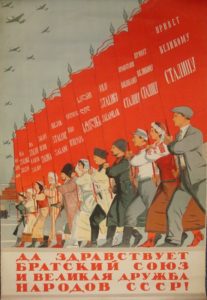Do you think this person is white?
If you are from Europe or North America, you might have said yes. If you are from Russia, you might have described this person as black. Most IR peeps are familiar with the fluid perceptions of whiteness and blackness that exist in the word: Sandor Gilman wrote, for instance, how Irish immigrants in the US in the beginning of the century were often considered black. The irony of blackness could not be more poignant in Russia: the famous Russian Armenian actor Frunzik Mkrtchan whose picture I put above is literally Caucasian, because he comes from the South Caucasus region in the European South of Russia. The ones who would describe him as black would also very likely to adhere to “Russia for [ethnic] Russians” slogan and in worst case scenarios would have tried to kill him because he “doesn’t look Slavic enough”.
Derogatory terms like ‘kavkazcy’ (Caucasians), and ‘chyornye’ (blacks) have become ubiquitous in everyday speech in Russia, while Russian mass media employs euphemisms such as ‘litsa neslavyanskoy vneshnoti’ (non-Slavic looking people) when it comes to the identification of crime suspects. A xenophobic discursive representation applies to non-Slavic looking individuals irrespective of their citizenship, even though former USSR citizens can seek Russian nationality under a simplified naturalisation procedure, according to the Federal Law on Citizenship. Apart from “Caucasians” who are often discursively connected to terrorism and ethnic criminality, there isn’t much love for former Soviet citizens from Central Asia. If you are not Ivan Drago or Natasha, you might have a lot of trouble even renting an apartment.
A lot of neo-Nazis love Russia because they think of it as the last white country. Hate (not) to disappoint them, but it’s not the case. Russia is a home to more than 190 ethnic groups that speak more than 100 languages. In Soviet Union that glorified ethnic differences on paper would often portray the multitude of ethnic groups thusly:
Welcome to colonialism, Russian style. Non-Slavs in the Russian Empire were called “tuzemcy” (natives) who were considered and treated as inferior to the ethnic and Orthodox Russians. This narrative could be explained partly by the almost ubiquitous knowledge among Russians of Russian 19th century literature on the Caucasian war (Tolstoy, Pushkin, Lermontov, etc.), where people from the Caucasus were romanticized in their “savage” otherness. At the same time, the Soviet regime, an ‘affirmative action empire’, glorified ‘internationalism’ and suppressed manifestations of nationalism, but at the same time each ethnic group was related to a particular territorial entity and was only recognized as such in relation to a subject of the federation. Soviet nationality policies started with korenizatsiya (indigenization) and finished with Russification that led to the fostering of ‘national cadres’ and the purging of local independence movements. Thus, the Soviet Union’s policy was to promulgate a “friendship of the peoples” discourse, where Russians were supposed to be the other nations’ “older brother”.
Soviet cinema contributed to the perception of ethnic minorities as “noble savages” that have their own traditions and culture in their own enclaves. A notable example is a Soviet favourite comedy “Kidnapping Caucasian Style” (watch it online with English subtitles!), where Nina – a ‘sportswoman, Komsomol member [communist youth organization], and a beauty’ – attracts the attention of a local bureaucrat who “buys” her as a wife from her uncle (the actor above) for the price of a herd of sheep, a fridge, and certificate of honour. The “ritual” kidnapping goes awry when a white, non-Caucasian student gets caught up in the situation and rescues Nina from the forced marriage. Even though the movie is a comedy and a spoof on outdated mores, it emphasized seemingly Caucasian traditions such as arranged marriage, female inferiority, and blood vengeance. The overblown visual representation of “savages” makes them look less threatening, but is still based on tourist perceptions of how Caucasians are supposed to look.
One might argue that Soviet pop culture representations are passé, but here is a fresh example. A 2015 viral video entitled “I am a Russian occupant” described Russian military history in such a way to present the occupation of Siberia, the Baltic countries, and Central Asia, as events that systematically led to industrialization and the improvement in the quality of life of indigenous population. The video played on typical imperial colonizing tropes. In the case of Siberia ‘women can no longer be sold for a pack of sable skins’ and instead live in industrialized cities with kindergartens. The citizens of Baltic countries ‘who asked the Russians to leave’ are now ‘cleaning toilets in the European Union’ while during the Soviet era they produced electronic equipment and cars.
At the end of the video the narrator says that he ‘doesn’t need your [Western] hypocritical liberty and rotten democracy’, illustrating them with photos of Pussy Riot, Conchita Wurst and Charlie Hebdo caricatures. Given that the video was provided with subtitles in different languages, its intended audience was well beyond Russian borders. This video is characteristic of the tension that exists in the pro-governmental understanding of Russia as a state. On the one hand, the ‘Russian occupant’ maintains his right to imperial conquests, justified as a ‘mission civilisatrice’. On the other hand, this both imperial and colonial mission is profoundly xenophobic and reflects current attitudes towards ethnic Others. According to this narrative, only ethnic Russians are a civilized nation, able to improve the condition of other ethnic groups on Russian territory. Thus, the empire needs ‘royal subjects’ in order to maintain its great power status, but the subjects are treated as inferior and are not supposed to question the (cultural) superiority of the dominant group.
According to public opinion polls, about 52% of Russians would like to implement the idea of “Russia for ethnic Russians” in some way and generally agree with the xenophobic and colonial tropes: close off the borders with Central Asia (heads up, travel ban) or implement strict internal migration regulations (Muslim registry, anyone?). And yes, there is racial profiling and racially motivated violence as well. At least elections in Russia a racism free: no gerrymandering or voting restrictions. Too bad everybody knows who is going to win.
Elizaveta Gaufman is Assistant Professor of Russian Discourse and Politics at the University of Groningen, the Netherlands. She is the author of "Everyday Foreign Policy: Performing and Consuming the Russian Nation after Crimea" (2023) and "The Trump Carnival: Populism, Transgression and the Far Right" (2024).



Thank you for this post, Lisa. One place where my debates w/ most Russians and pro-Russians invariably fall apart–the full spectrum, from russo-supremacist to soft nationalists to pro-western liberals– is this, race. From now on, I am going to simply use this link. As far as this world goes, the decline of anti-racism–both ‘mainstreamed’ and ontological, however tenuous–has been precipitous.
Thank you for your lovely comment! Racism always invents a “black” person to discriminate against
How kind of you to impute racism to “most” Russians across “the full spectrum”. And not at all hypocritical.
I think what the previous speaker implied is that you can encounter racism in different segments of Russian society which has been my experience as well, both academic and personal.